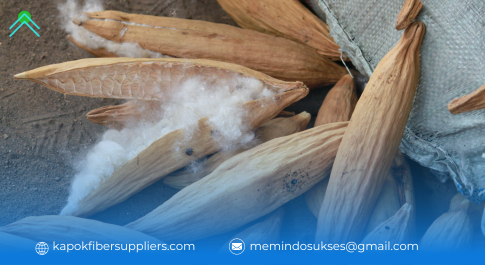
Kapok: The Unseen Hero in Sustainable Materials
Kapok, a natural fiber that has been used for centuries, is gaining recognition as an eco-friendly alternative in a world that’s increasingly focused on sustainability. Often overshadowed by synthetic materials, this lightweight, biodegradable fiber has a long history of practical uses and is now being rediscovered for its environmental benefits. Let’s explore why kapok is not just a relic of the past, but a powerful resource for a sustainable future.
The Origin and Unique Properties of Kapok
Kapok comes from the seed pods of the Ceiba pentandra tree, a towering species found in tropical regions around the world. This majestic tree can grow up to 200 feet tall, and its pods contain soft, fluffy fibers that are harvested for various uses. Kapok fibers are hollow, which makes them lighter than cotton and highly buoyant. Because they trap air and resist moisture, they can withstand humid conditions without deteriorating, making them ideal for a variety of applications.
The uniqueness of kapok lies in its exceptional lightness and airiness. These properties have made it a popular choice for products that need to be both comfortable and durable without adding weight. However, despite its great potential, it remains relatively underutilized compared to other natural fibers.
Why Kapok Deserves More Attention
- A Solution for Lightweight Needs: Due to its hollow structure, kapok is one of the lightest fibers available. It has been used as a filling in pillows, mattresses, and cushions, offering a natural softness that rivals synthetic alternatives. Unlike polyester or foam, kapok does not retain heat, making it a perfect choice for tropical climates where breathability is important.
- A Buoyant Fiber: Historically, kapok was used to make life jackets and flotation devices because of its remarkable buoyancy. Its ability to float on water without absorbing moisture makes it a reliable material for safety gear, particularly in maritime industries.
- Water-Resistant Qualities: Kapok is naturally resistant to water and mold. In humid or rainy conditions, where cotton or other fibers might degrade, kapok retains its integrity. This makes it an excellent option for products exposed to wet environments, such as outdoor cushions or eco-friendly insulation.
- Eco-Friendly and Biodegradable: As the world shifts away from synthetic, petroleum-based products, kapok presents a biodegradable alternative. Its natural composition breaks down easily without leaving harmful residues, making it far more environmentally friendly than many synthetic fibers.
The Environmental Edge of Kapok
Kapok trees themselves contribute to environmental sustainability. These trees grow without the need for intensive farming practices. Unlike many commercial crops that require land clearing and heavy irrigation, kapok trees thrive naturally in tropical forests, where they help maintain the ecosystem. Harvesting kapok involves simply collecting the fiber from the seed pods, a non-destructive process that does not harm the tree.
Kapok trees are also known for their ability to absorb large amounts of carbon dioxide. By growing and thriving in tropical climates, they play a role in mitigating climate change by capturing CO2 from the atmosphere. As demand for sustainable materials grows, promoting the cultivation of kapok trees could be a valuable tool in efforts to combat deforestation and reduce carbon footprints.
Expanding Kapok’s Role in Modern Industry
Though kapok has been used for centuries in products like mattresses, cushions, and life jackets, its potential goes far beyond these traditional applications. In the face of climate change and environmental degradation, industries are beginning to look for greener alternatives to conventional materials.
- Textiles and Fashion: Kapok’s soft, lightweight nature makes it an excellent candidate for the fashion industry, especially in creating eco-friendly garments. While it’s not yet as widely used as cotton or wool, researchers are exploring ways to process kapok into fibers suitable for fabric production.
- Packaging and Insulation: As sustainability becomes a priority in packaging, kapok’s lightness and insulating properties make it an ideal candidate for biodegradable packaging. In addition, its use as a natural insulating material is gaining attention for use in eco-friendly construction.
- Healthcare and Pharmaceuticals: The medical field is also beginning to explore kapok’s potential. With its hypoallergenic properties, kapok could be used in the production of medical cushions or other devices where comfort and cleanliness are essential.
Challenges and Opportunities
Despite its many advantages, kapok faces challenges in terms of mass production and processing. The fiber is delicate, and harvesting requires careful handling to preserve its quality. Additionally, the lack of large-scale infrastructure for processing kapok means it is often overshadowed by more common fibers. However, as demand for sustainable products rises, there is a growing opportunity to develop more efficient processing techniques that could make kapok a mainstream material.
The Future of Kapok: A Green Revolution?
Kapok may not yet be a household name, but its potential as a sustainable material is vast. As more industries embrace eco-friendly alternatives, the demand for natural fibers like kapok is poised to grow. Its lightness, buoyancy, water resistance, and biodegradability make it a strong contender in the push for a greener, more sustainable future.
In a world that is increasingly focused on reducing its carbon footprint and moving away from plastic and petroleum-based products, kapok offers a natural solution that’s been here all along. By reintroducing this fiber into modern industries, we can move one step closer to a more sustainable and eco-conscious world.
Conclusion
Kapok is a fiber with great promise, yet it remains a largely untapped resource in the world of sustainable materials. With its natural properties of lightness, buoyancy, and water resistance, it is an ideal alternative to synthetic options in industries ranging from textiles to safety equipment. As we continue to seek out greener alternatives to traditional materials, kapok stands ready to play an important role in shaping a more sustainable future.

